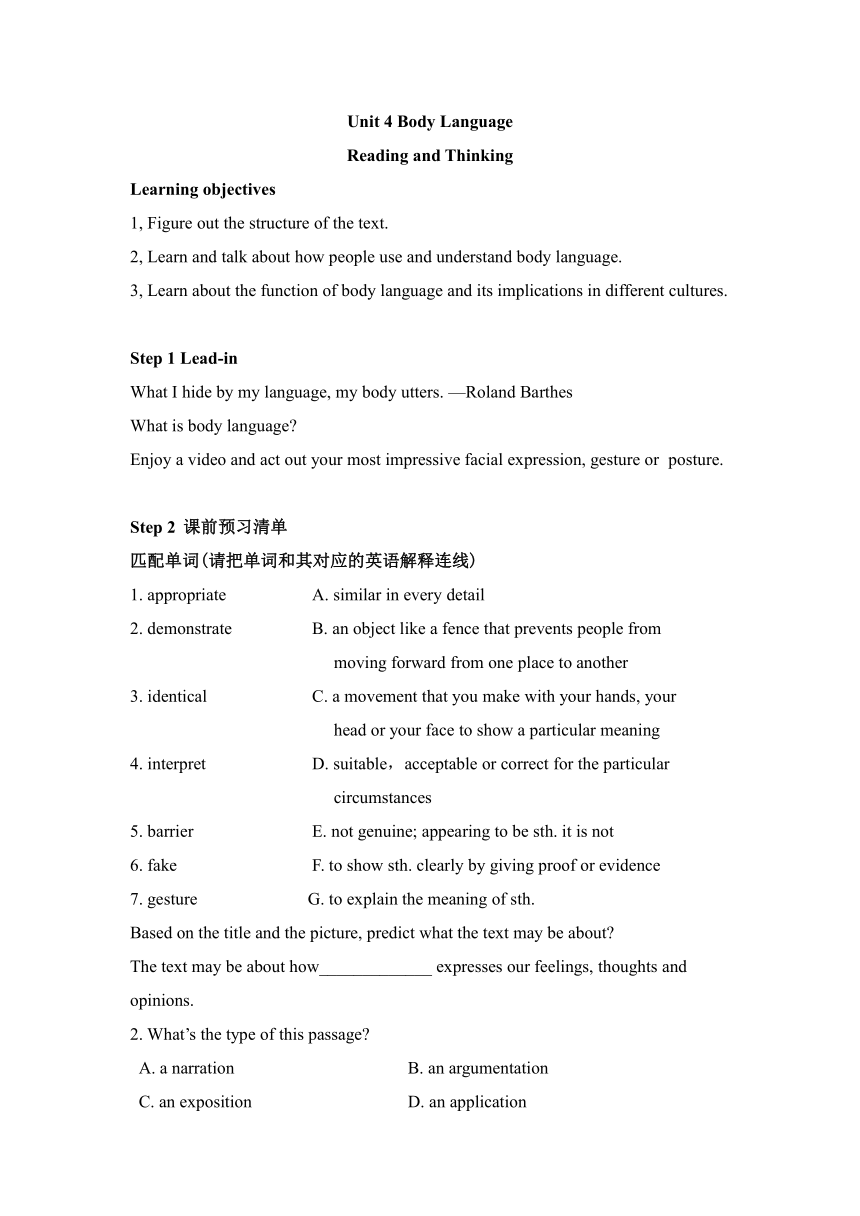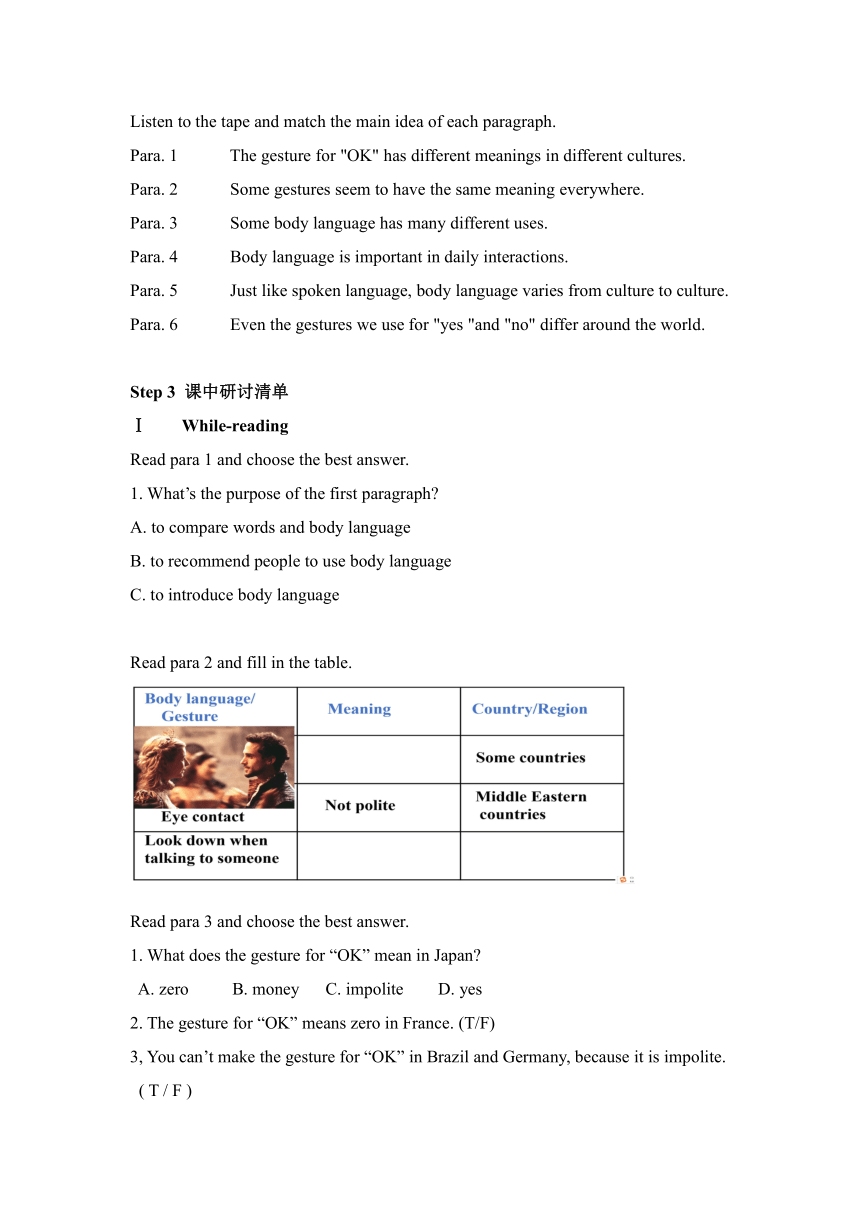人教版(2019)选择性必修 第一册Unit 4 Body Language reading and thinking导学案(无答案)
文档属性
| 名称 | 人教版(2019)选择性必修 第一册Unit 4 Body Language reading and thinking导学案(无答案) |

|
|
| 格式 | docx | ||
| 文件大小 | 888.1KB | ||
| 资源类型 | 教案 | ||
| 版本资源 | 人教版(2019) | ||
| 科目 | 英语 | ||
| 更新时间 | 2023-12-16 20:45:35 | ||
图片预览


文档简介
Unit 4 Body Language
Reading and Thinking
Learning objectives
1, Figure out the structure of the text.
2, Learn and talk about how people use and understand body language.
3, Learn about the function of body language and its implications in different cultures.
Step 1 Lead-in
What I hide by my language, my body utters. —Roland Barthes
What is body language
Enjoy a video and act out your most impressive facial expression, gesture or posture.
Step 2 课前预习清单
匹配单词(请把单词和其对应的英语解释连线)
1. appropriate A. similar in every detail
2. demonstrate B. an object like a fence that prevents people from
moving forward from one place to another
3. identical C. a movement that you make with your hands, your
head or your face to show a particular meaning
4. interpret D. suitable,acceptable or correct for the particular
circumstances
5. barrier E. not genuine; appearing to be sth. it is not
6. fake F. to show sth. clearly by giving proof or evidence
7. gesture G. to explain the meaning of sth.
Based on the title and the picture, predict what the text may be about
The text may be about how_____________ expresses our feelings, thoughts and opinions.
2. What’s the type of this passage
A. a narration B. an argumentation
C. an exposition D. an application
Listen to the tape and match the main idea of each paragraph.
Para. 1 The gesture for "OK" has different meanings in different cultures.
Para. 2 Some gestures seem to have the same meaning everywhere.
Para. 3 Some body language has many different uses.
Para. 4 Body language is important in daily interactions.
Para. 5 Just like spoken language, body language varies from culture to culture.
Para. 6 Even the gestures we use for "yes "and "no" differ around the world.
Step 3 课中研讨清单
Ⅰ While-reading
Read para 1 and choose the best answer.
1. What’s the purpose of the first paragraph
A. to compare words and body language
B. to recommend people to use body language
C. to introduce body language
Read para 2 and fill in the table.
Read para 3 and choose the best answer.
1. What does the gesture for “OK” mean in Japan
A. zero B. money C. impolite D. yes
2. The gesture for “OK” means zero in France. (T/F)
3, You can’t make the gesture for “OK” in Brazil and Germany, because it is impolite.
( T / F )
Read para 4 and fill in the table.
Read para 5 and choose the best answer.
1. What will you do to express “I am full”
A. Placing your hands together.
B. Placing your hands on the stomach.
C. Shaking your head.
D. Moving your hand in circles over your stomach.
Read para 6 and find out the different uses of smile.
Ⅱ Post-reading
What advice on body language can you give a foreign friend on his/her first trip to China
In China, when people meet, it is proper for us to ________________(和别人握手) rather than _______________(亲吻手背), and keep _______________(一个适当的距离).
In China, it’ s good manners to ____________(保持微笑) and have ___________(眼神交流)when talking to others.
In China, when we sit or stand, we’d better not __________________ (跷着二郎腿坐着)or ______________________ (双臂交叉的站着).
Ⅲ Summary
1. What’s the structure of this passage
2. Where can we most probably read this passage
A. a newspaper B. a romantic fiction
C. a journal of social culture D. a website
Step 4 课后练习清单
Fill in the blanks according to the text.
We use both words and body language __________(express) our thoughts and opinions. Just like spoken language, body languages are _________(vary) from culture to culture. The crucial thing is using body language in _____ appropriate way. For instance, making eye contact in some countries is a way to display interest ________ in many Middle Eastern countries, men and women are not socially permitted to make eye contact. The gesture “OK” has different meanings in different cultures. In Japan, a person who witnesses another person ________ (employ) the gesture might think it means money. However, you should avoid making this gesture in Brazil and Germany, ________ it is not considered polite. In many countries, shaking one’s head means “no” and nodding means “yes”. By _________ (compare), in Bulgaria, the gestures have opposite meaning. There are also differences in how we act when we meet or part. In countries like France and Russia, people may kiss their friends _____ the cheek when they meet. The most universal body language is smile. It can help us get through difficult ___________ (situation) and find friends in a world of strangers. Experts suggest _________(smile) at yourself in the mirror to make yourself happier and stronger.
Reading and Thinking
Learning objectives
1, Figure out the structure of the text.
2, Learn and talk about how people use and understand body language.
3, Learn about the function of body language and its implications in different cultures.
Step 1 Lead-in
What I hide by my language, my body utters. —Roland Barthes
What is body language
Enjoy a video and act out your most impressive facial expression, gesture or posture.
Step 2 课前预习清单
匹配单词(请把单词和其对应的英语解释连线)
1. appropriate A. similar in every detail
2. demonstrate B. an object like a fence that prevents people from
moving forward from one place to another
3. identical C. a movement that you make with your hands, your
head or your face to show a particular meaning
4. interpret D. suitable,acceptable or correct for the particular
circumstances
5. barrier E. not genuine; appearing to be sth. it is not
6. fake F. to show sth. clearly by giving proof or evidence
7. gesture G. to explain the meaning of sth.
Based on the title and the picture, predict what the text may be about
The text may be about how_____________ expresses our feelings, thoughts and opinions.
2. What’s the type of this passage
A. a narration B. an argumentation
C. an exposition D. an application
Listen to the tape and match the main idea of each paragraph.
Para. 1 The gesture for "OK" has different meanings in different cultures.
Para. 2 Some gestures seem to have the same meaning everywhere.
Para. 3 Some body language has many different uses.
Para. 4 Body language is important in daily interactions.
Para. 5 Just like spoken language, body language varies from culture to culture.
Para. 6 Even the gestures we use for "yes "and "no" differ around the world.
Step 3 课中研讨清单
Ⅰ While-reading
Read para 1 and choose the best answer.
1. What’s the purpose of the first paragraph
A. to compare words and body language
B. to recommend people to use body language
C. to introduce body language
Read para 2 and fill in the table.
Read para 3 and choose the best answer.
1. What does the gesture for “OK” mean in Japan
A. zero B. money C. impolite D. yes
2. The gesture for “OK” means zero in France. (T/F)
3, You can’t make the gesture for “OK” in Brazil and Germany, because it is impolite.
( T / F )
Read para 4 and fill in the table.
Read para 5 and choose the best answer.
1. What will you do to express “I am full”
A. Placing your hands together.
B. Placing your hands on the stomach.
C. Shaking your head.
D. Moving your hand in circles over your stomach.
Read para 6 and find out the different uses of smile.
Ⅱ Post-reading
What advice on body language can you give a foreign friend on his/her first trip to China
In China, when people meet, it is proper for us to ________________(和别人握手) rather than _______________(亲吻手背), and keep _______________(一个适当的距离).
In China, it’ s good manners to ____________(保持微笑) and have ___________(眼神交流)when talking to others.
In China, when we sit or stand, we’d better not __________________ (跷着二郎腿坐着)or ______________________ (双臂交叉的站着).
Ⅲ Summary
1. What’s the structure of this passage
2. Where can we most probably read this passage
A. a newspaper B. a romantic fiction
C. a journal of social culture D. a website
Step 4 课后练习清单
Fill in the blanks according to the text.
We use both words and body language __________(express) our thoughts and opinions. Just like spoken language, body languages are _________(vary) from culture to culture. The crucial thing is using body language in _____ appropriate way. For instance, making eye contact in some countries is a way to display interest ________ in many Middle Eastern countries, men and women are not socially permitted to make eye contact. The gesture “OK” has different meanings in different cultures. In Japan, a person who witnesses another person ________ (employ) the gesture might think it means money. However, you should avoid making this gesture in Brazil and Germany, ________ it is not considered polite. In many countries, shaking one’s head means “no” and nodding means “yes”. By _________ (compare), in Bulgaria, the gestures have opposite meaning. There are also differences in how we act when we meet or part. In countries like France and Russia, people may kiss their friends _____ the cheek when they meet. The most universal body language is smile. It can help us get through difficult ___________ (situation) and find friends in a world of strangers. Experts suggest _________(smile) at yourself in the mirror to make yourself happier and stronger.
